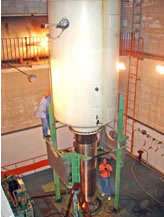
The central equipment of the Van de Graaff Laboratory is a 4 MV electrostatic accelerator, model KN 4000, manufactured by High Voltage Engineering Corporation. A 1.23 tesla electromagnet analyzes the accelerated ion beams; the selected beam is deflected into the 90° output. Common atomic ion beams are constituted by protons, deuterons, He+, He++, Cn+, Nn+ , On+ or Arn+ ions; molecular beams are H2+, H3+ and N2+. Acceleration voltages range from 200 kV to 3,5 MV, and tens of nA are typical beam currents reaching the target. Laboratory activities are mainly directed towards material analyses of thin films or solid surfaces. Common targets are condensed gases, organic material, alloys and minerals. The installed analytical techniques are: Fourier Transform InfraRed spectroscopy (FTIR), Rutherford Backscattering (RBS), Elastic Recoil Detection Analysis (ERDA), Particle-Induced X-ray Emission (PIXE) and Time-of-Flight Plasma Desorption Mass Spectrometry (TOF-PDMS). The ion beams may also be used for Ion Beam Modification of Materials (IBMM).
The switching magnet selects one, out of seven possible shipping beam lines. At this time, there are four shipping beam lines equipped with analytical techniques:
- 300–right line: high vacuum (HV) analysis chamber for RBS and ERDA.
- 150–right line: high vacuum (HV) analysis chamber for PIXE.
- 150–left line: ultra-high vacuum (UHV) analysis chamber for FTIR analysis, equipped with RGA mass spectrometry, 2 keV electron gun, 2 keV ion gun and 10 K cryostat.
- 450–left line: ultra-high vacuum (UHV) analysis chamber for PDMS analysis, equipped with a 252Cf source and 10 K cryostat.
In the last years, the main experiments carried out in the Laboratory were: ion induced processing, sputtering yield and destruction cross section measurements on ices (for astrophysical purposes), chemical reactions and crystallization modification induced by ion beams in prebiotic materials (for astrobiology purposes), study of radiation effects on living cells, and ion induced modification of meteorites afterward analyzed by UV-VIS-IR spectroscopy (for the study of solar wind – space weathering processes).
